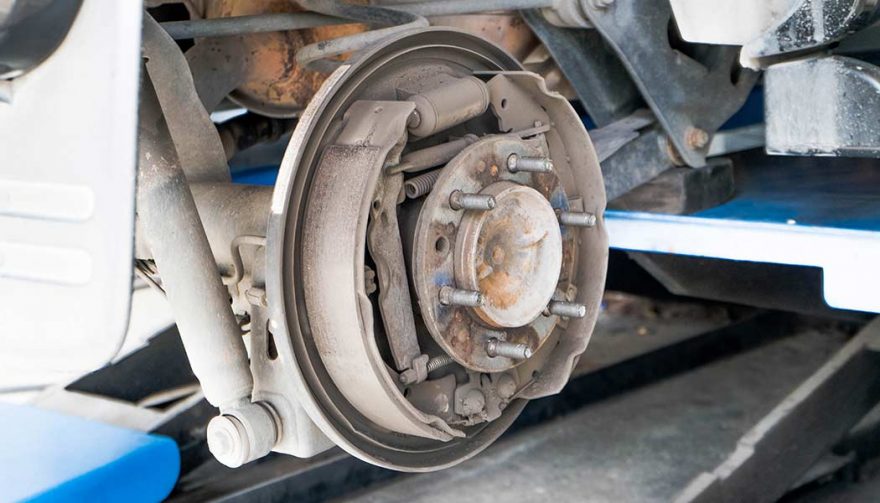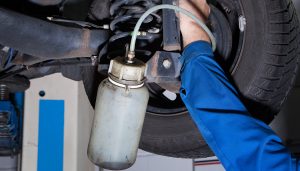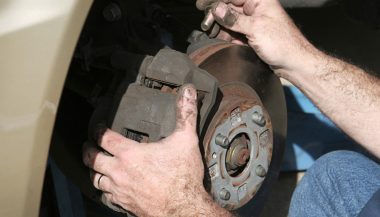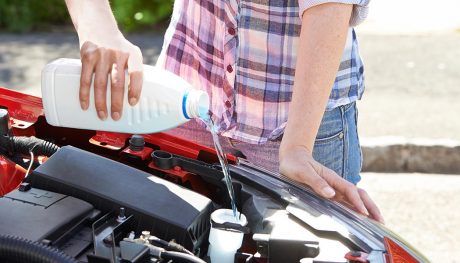
Snap a pic of your drum brakes before your repair, it'll make reassembly easier.
Drum Brakes Repair Secrets
Years ago good mechanics kept a bottle of baby powder in their toolbox. They used it to fix drum brakes. How? After a brake “reline” job, it was not unusual for cars to have a brake pull. Hit the brakes hard and the car would want to change lanes by itself.
That happened because one brake was grabbing harder than the brakes on the other side of the car. The pull was worse on front brakes, because they directly affect the steering. When one front brake grabs, it yanks on the steering linkage, making the car want to steer itself in that direction. To stop the pull, mechanics would sprinkle a little baby powder on the grabbing brake shoes. That allowed the newly relined shoes to break in normally. That’s just one of many tricks of the trade.
In this article we’ll talk about drum brake repair tips, and also touch on parking brake issues. This will be handy information to have if you are doing a resto-mod, or even if you have a newer car that has drum brakes on the rear wheels. (Interested in more brake repair secrets? Click here.)
Drum Brakes Are Unforgiving of Mistakes
Disc brakes are very forgiving of sloppy repair work and general uncleanliness, but drum brakes are just the opposite. They are finicky. If everything on a repair isn’t done just right, drum brakes can cause some real aggravation. Here are some tips to help you avoid those troubles.
Clean It off the Safe Way
First, wash the drum brake components thoroughly before disassembly. But don’t blow the dust off with compressed air – this is very important. While brake shoes no longer contain asbestos, breathing brake dust is still not good. The resins in the brake dust will stay in your lungs forever. So spray the brake assembly off with soap and water to prevent all that dust from flying around, getting on your clothes, and making a general mess.
Buy a few empty spray bottles from the dollar store, and mix a little dish washing detergent (again from the dollar store if you’re smart) with warm water. Use it to spray the brake shoes and attaching hardware. Soak it really good. Use a brush on the heavy build up. Give it a good bath. Catch the runoff in a big plastic drain pan, which you bought, right, at the dollar store.
When everything is really clean you can then dry it off with compressed air, or with some spray brake cleaner.
Pictures Help Us Learn, and Remember
Next take pictures of all the hardware, springs and weird-looking pieces before you take anything apart, because you probably won’t remember how everything is supposed to fit back together. Disassemble and work on one wheel at a time. If it’s your first time working on drum brakes, you will find it helpful to have an untouched brake assembly as a visual reference point to see how all the parts connect to each other. That will help you assemble everything correctly.
Install Shoes in the Correct Positions
Notice that each wheel has one brake shoe with a longer friction material surface than the other shoe. The bigger shoe is called the primary shoe, because it provides most of the stopping force on that wheel. The smaller shoe on that wheel is called the secondary shoe. While it does provide some stopping force, its main function is to wedge the primary shoe into the brake drum. It works like this: the harder you brake, the more the rotating drum tries to grab the secondary shoe, and then drive it toward the primary shoe (try to picture it happening). But the primary shoe is anchored into place by the stationary wheel cylinder. So the driving force from the secondary shoe wedges the primary shoe much tighter into the brake drum. A very clever design, it multiplies force like a lever does. Drum brakes that incorporate that feature are called self-actualizing brakes. It sounds like Sigmund Freud named them.
Most older cars had the wheel cylinder bolted in place at the very top (12 o’clock position) of the brake assembly. So which brake shoe was the primary one? The shoe located at the rear of the assembly. Many people have mistakenly assumed that since the front brakes supply most of the car’s stopping force, the forward shoes on drum brakes do most of the work. No.
Buy the Right Tools
Next, when you start disassembling everything, don’t use pliers or vise grips. Brake tools are inexpensive, and will prevent injury. The return and hold down springs can fly off the car with great force when they slip out of ordinary pliers. It’s actually easy to take all the hardware apart and to put it back together using the correct tools, once you get the hang of it. Practice doing that on one wheel.
Back to Brake Pulls
Another less common cause of brake pulls is using drums machined to unequal diameters on the same axle. A little bit of difference between the left and right side drums is OK, but a great difference is not. For instance, don’t use a new drum on one side, and one that has been machined to its very outer limit on the other side. After your drums have been machined, ask to have them measured. If you can find an old repair manual, you will find the diameter specs buried somewhere in it.
As to machining, when drums are mounted on the cutting lathe they reference off their bearing races, which are press-fitted into the hub. Any pits in the races will prevent the drum (and rotors, too) from setting up correctly on the lathe. Improper setup causes the drum to get machined out of round, which will make the brake pedal pulsate under braking. So replace any bad races before having your drums machined.
Test Fit Your New Brake Shoes in Their Drums
Ideally, new brake shoes would have an arc that perfectly matches the diameter of the drum they will be working with. In the really old days (before my time), mechanics would use a special machine to grind the proper arc into the newly relined shoes. More asbestos inhaled.
Nowadays, factories simply estimate the average diameters of brake drums, then arc the new shoes into a slightly smaller diameter than that. That smaller arc will make the new shoes have an initial contact area in their centers, but that’s OK. They will gradually wear evenly toward both edges with use. Under hard braking, though, new shoes will flex a little, enough to fully contact their drums. Try to picture that happening.
Your new shoes should fit snugly within the drums, but have just a tiny bit of rocking motion end-to-end, because they contact at their centers. If by chance the new shoes contact the drums only at the ends of their friction material, and not at the center of the shoe, they will grab so badly that baby powder will not fix it. The shoes probably have a manufacturing defect. So test fit your new brake shoes into their drums first, before you install them. As we said, drum brakes are unforgiving of repair mistakes and oversights.
Replace Your Wheel Cylinders
We used to rebuild these. Mass manufacturing has made new replacements so affordable that it’s not worth rebuilding old wheel cylinders. It’s likely they are so old anyway that pits have developed in their bore surfaces.
Don’t agonize if you can’t get the steel brake line loose from the cast iron wheel cylinders. Steel will definitely seize into cast iron as the years go by. The other end of the steel brake line, though, will always terminate into brass, either a brass junction block on the rear axle, or a brass hose end on the front brakes. Brass will release the steel line fitting very easily. Simply disconnect it there, and buy a new steel brake line from your local auto parts store. Pick up an inexpensive tube bending tool while you are there, and use it to form your new line into the proper shape, using the old line as a reference for the bends and turns. You now have a new skill, tube bending.
Replace the Hardware Too
Return and hold down springs lose their tension from heat, age and use. Buy a replacement kit. It’s cheap, and avoids irritating brake problems. Disassemble the self-adjuster, clean the threads and assemble it with some anti-seize compound on the threads and on the rotating end. It has to be able to work very smoothly for the self-adjusting feature to operate properly. Otherwise you will have to manually adjust your brakes every few thousand miles. No fun.
Closely inspect the small pads on the stamped steel backing plates. That’s where the brake shoes rest against the backing plate. The shoes can wear grooves into the small pads, which will grab the shoes and prevent smooth operation. File any small grooves smooth. Lightly dab some white grease on the pads. If you don’t, and then assemble the brakes dry, you will hear a “squeak, squeak” noise as you step on the brakes with the car parked. Ask me how I know that.
Keep it Clean
Greasy fingerprints on new brake shoes will make them grab unevenly. To keep your new shoes clean while you work with them, first cover the friction surfaces with ordinary masking tape. Remove the tape only when everything is completely assembled, right before you adjust them. If you do get some greasy fingerprints on your new brake shoes, simply buff them off with sandpaper. Don’t use spray brake cleaner or liquids of any type, as sprays and liquids will get absorbed into the new friction material.
If you have difficulty installing the parking brake cable on your new brake shoes (everybody does) try this. Loosen the parking brake cable adjuster, the one under the car, completely. That will give you a lot more free play at the shoe to work with. Before you re-tighten the parking cable adjuster, though, put some anti-seize on its threads. You probably won’t be adjusting it again for years.
Adjust It Right
Before you adjust your new brakes, the parking brake cable has to be completely released, have slack in it, and able to move freely. Those cables can seize from disuse, and do, because many people don’t use the parking brake. The best maintenance for them is to apply the parking brake every time you park. That keeps the cables moving freely. You can’t lubricate them very well. That’s why I always thought parking brake cables should have grease fittings.
Adjust your new brake shoes to fit the drums with a very light drag, bleed your brake system, and then step on the brake pedal a few times to seat the shoes into position. Then recheck your adjustments. Likely you will have to take up a little more slack in the shoe’s self-adjusters, which will give you a better brake pedal feel. Only after the brakes have been adjusted properly can you correctly adjust the parking brake cable.
On cars with foot-operated parking brakes, there are under dash components that can develop rust with age. WD40 works great freeing them up. You could apply some motor oil too, but keep in mind that any oil or grease will attract and hold dust.
Closing Tips
Remember that drum brakes trap heat, since there is no moving air flow inside the drums to cool them off. So don’t overheat them as you break the new shoes in.
The self-adjusting mechanism will only work when the brakes are applied firmly in reverse. If the pedal feels mushy or sinks too close to the floor, back up several times, and hit the brakes firmly each time. On some cars, you actually have to back up, brake firmly to a stop, go forward, and brake firmly to make the adjusters work. It takes a complete reverse-forward cycle to force the adjusters to click once. Try to picture that happening. Nothing about drum brakes is intuitive, as it is with simple disc brakes.
That’s it. If you are lucky, you won’t need the baby powder to cure any brake pulls. Share this article with someone you know who works on their own car. He or she will thank you.





